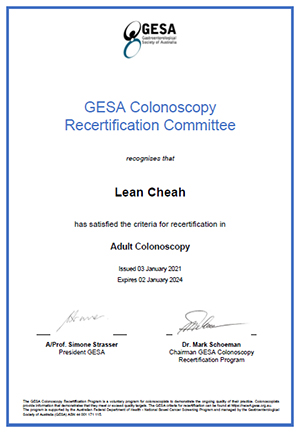RECTAL BLEEDING
RECTAL BLEEDING
Passing blood in the stools can be very alarming. There are many different possible causes for bleeding and a careful detailed history and examination is needed to help identify the cause.
It is important to see a medical practitioner for advice should you have any rectal bleeding and not assume that the bleeding is simply due to haemorrhoids. (Many surgeons have come across cases of advanced bowel/anal cancer that have been ignored where the bleeding has been attributed to haemorrhoids!)
Bright Red Blood on Toilet Paper/Toilet Bowl
Usually this is due to haemorrhoids. It can also be due to an anal fissure(a tear in the anal canal) if it is very painful to pass motions or more rarely an anal cancer. Also any recent perianal surgery(eg excision of anal skin tags, drainage of abscess, haemorrhoidectomy) may cause some bleeding.
Blood mixed with stools
This can be very serious and bowel cancer needs to be excluded. Other causes include inflammatory bowel disease, some types of gastroenteritis/infective colitis and ischaemic colitis.
Passing frank blood with or without blood clots(Haematochezia)
This is often due to diverticular disease or angiodysplasia(a benign condition where there are blood vessels on the lining of the bowel). Bowel cancer again needs to be excluded.
Melaena / Black tarry stools
This is often due to blood that has been in the intestines for a longer time such as bleeding from a peptic/stomach ulcer.
CLINICAL EXAMINATION
A general abdominal examination is performed. This is followed by an inspection of the perianal area to look for any skin tags, prolapsed haemorrhoids or cancerous lumps(eg Anal cancer) is neccessary. This should then be followed by a digital examination of the anal canal and lower rectum(to feel for any polyps and also to check the prostate)
A proctoscopy/sigmoidoscopy to look at the inner lining of the anal canal and lower rectum(usually up to around 15-20cm from the anal verge) is then performed. Air is insufflated into the rectum in order to get a better view of the lining(mucosa). One may feel the urge to pass flatus at this stage.
FURTHER INVESTIGATIONS
Colonoscopy - especially to look for lesions higher up. This can also be used to biopsy the lining of the colon and remove polyps found. (Proctoscopy - for looking at haemorroids; Sigmoidoscopy - to look at the rectum and sigmoid colon)
Gastroscopy - this is needed if there is black tarry stools in order to look at the stomach and duodenum: the two sites of peptic ulcers.
Full blood count - this is to look for the anaemia and its severity.
Capsule Endoscopy(Pill Camera study) - if no cause is found from a gastroscopy or colonoscopy and there is persistent bleeding/ongoing iron deficiency anaemia.
TREATMENT
Banding of Haemorrhoids - this involves placing a rubber/plastic band around the neck of the haemorrhoids in the lower rectum. (It is important that the band be placed higher than the anal canal to reduce the amount of discomfort). The band will strangulate the haemorrhoids and will fall off usually within a week or two. Risks - uncommon: feeling faint, bleeding when the band falls off.
Bowel cancer would need surgery to resect the cancer and the lymph glands that the area drains to.
Anal cancer would need treatment with radiotherapy and chemotherapy.
Inflammatory bowel disease can be treated with medications but an acute flare-up may require hospital admission.
Infective causes(eg from bacteria or parasites) of rectal bleeding may need treatment with antibiotics.
Massive bleeding (eg from diverticular disease or angiodysplasia) or melaena would require admission to hospital.
By and large, the majority of the cases of bright red bleeding seen are not due to cancers - mostly due to haemorrhoids, anal fissures/trauma etc. However a few cases are notable
Elderly woman - has had long-standing perianal bleeding with blood on the toilet paper which she attributes to haemorrhoids. Recently noted to have anaemia. On examination, had a lump close to her anus(this lump looked like a thrombosed external haemorrhoid but was felt much harder)- this lump on biopsy turned out to be an anal cancer.
Middle-aged woman with painful defaecation with small amount of blood on the toilet paper. Was too sore to undergo digital rectal examination. She was treated initially as a case of anal fissure. At a later stage when examined under anaesthesia, she was found to have a low rectal cancer invading into her anal canal.
Elderly man with a long-standing "rash" around his anus with small amount of bleeding. On biopsy, this rash turns out to be a cancer(Paget's disease of the anus)
Young woman in her 20s presents having passed some bright blood on her toilet bowl that seems consistent with haemorrhoids. She is reviewed again a few months later and this time has abdominal pain. A colonoscopy was performed and she was found to have a bowel cancer on her right colon.
Elderly woman referred with ongoing intermittent bright red bleeding. She has had a colonoscopy over a year ago by a gastroenterologist - at that time she was diagnosed as having haemorrhoids only. Colonoscopy was repeated - a low rectal cancer was found. She went on to have an abdomino-perineal resection(APR) - excision of the anus, rectum and formation of a colostomy.


